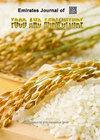玉米和大豆轮作后,通过接种巴西鹅膏菌(Azospirillum brasilense)促进黑燕麦和黑麦草的生长
IF 0.7
4区 农林科学
Q3 AGRONOMY
引用次数: 0
摘要
由于成本高昂,氮肥管理不当会影响冬季牧草的营养和产量,因此需要采用可持续的替代方法,如使用固氮菌。这项研究评估了接种了巴西天青球根瘤菌(Azospirillum brasilense)的黑燕麦(Avena strigosa)和黑麦草(Lolium multiflorum)植物的生长促进作用。实验在巴西圣玛丽亚连续进行了两季。黑燕麦的播种密度为每平方米 300 粒有活力的种子,黑麦草的播种密度为每平方米 100 粒有活力的种子。接种剂的剂量为每公斤种子 5 毫升。播种后,通过轻耙将种子纳入土壤。在分蘖初期,施用 50 千克/公顷的氮,形成有氮和无氮处理。对出苗率、株高、叶片数和分蘖数进行了评估。第一年,黑燕麦的出苗株数 m-2 出现了接种反应。第二年(玉米秸秆),黑燕麦的叶片数和高度都出现了接种反应。在大豆秸秆下,燕麦叶片数和黑麦草分蘖数均出现接种反应。目前的研究突出表明,接种巴西天青霉(Azospirillum brasilense)能有效促进饲料作物形态成分的显著改善。接种玉米后,黑燕麦的叶片和分蘖数量以及高度都有所增加。同样,在大豆之后,黑燕麦的分蘖数量和黑麦草的叶片数量也有所增加。研究结果强调了接种的重要性,接种是一种有效的做法,可以提高农业系统中作物的生长发育和表现,提高大豆和玉米残留物的可持续性和生产率。本文章由计算机程序翻译,如有差异,请以英文原文为准。
Promoting black oat and ryegrass growth via Azospirillum brasilense inoculation after corn and soybean crop rotation
Inadequate management of nitrogen fertilization, due to high costs, compromises the nutrition and productivity of winter forage plants, highlighting the need to adopt sustainable alternatives, such as using nitrogen-fixing bacteria. This research evaluated the growth promotion of black oat (Avena strigosa) and ryegrass (Lolium multiflorum) plants inoculated with Azospirillum brasilense rhizobacteria. The experiments were carried out over two consecutive harvests in Santa Maria, Brazil. The sowing density was 300 viable seeds per square meter for black oats and 100 viable seeds per square meter for ryegrass. A dose of 5 ml per kg of seeds from the consortium was used as an inoculant. Following sowing, the seeds were incorporated into the soil through light harrowing. At the beginning of tillering, 50 kg of N ha-1 was applied to create treatments with and without nitrogen. Plant emergence, plant height, number of leaves and tillers were evaluated. In the first year, an inoculation response was observed for the number of black oat plants emerged m-2. In the second year (corn residue), an inoculation response was observed for the number of leaves and height of black oats. Under soybean straw for oat leaf number and ryegrass tiller number. The current research highlights the effectiveness of inoculation with Azospirillum brasilense in promoting significant improvements in the morphological components of forage crops. Following corn, an increase in the number of leaves and tillers was observed, as well as in the height of black oats. Similarly, following soybeans, there was an increase in the number of black oat tillers and the number of ryegrass leaves. The results emphasize the importance of inoculation as an effective practice to enhance crop development and performance in agricultural systems, improving sustainability and productivity under soybean and corn residues.
求助全文
通过发布文献求助,成功后即可免费获取论文全文。
去求助
来源期刊

Emirates Journal of Food and Agriculture
AGRONOMYFOOD SCIENCE & TECHNOLOGY&nb-FOOD SCIENCE & TECHNOLOGY
CiteScore
1.80
自引率
0.00%
发文量
18
期刊介绍:
The "Emirates Journal of Food and Agriculture [EJFA]" is a unique, peer-reviewed Journal of Food and Agriculture publishing basic and applied research articles in the field of agricultural and food sciences by the College of Food and Agriculture, United Arab Emirates University, United Arab Emirates.
 求助内容:
求助内容: 应助结果提醒方式:
应助结果提醒方式:


